After stepping off the Holborn tube stop, we followed the signs to the Sir John Museum and almost passed it on the street. It fits in so well with its neighboring houses that we nearly passed it. The only difference between the museum and the neighboring homes were two signs, one by the door and one on the gate. It’s set in a picturesque neighborhood across from Lincoln Inn Fields. The museum is a monument to Sir John, a premier British architect, from Sir John, a premier British architect. Sir John decided that instead of leaving his home and belongings to his children, he would create a museum that would house his eclectic collection of sculptures, paintings, and tchockes. While interesting and brief, the museum was almost confusing in layout and design of exhibitions. We understand that the layout is based on the three houses that he combined to create his home, but the exhibitions seemed to be crammed into whatever corner they might fit. Example, large stone sculptures over two stories tall in a hole in the ground floor to the basement. It was just a bit confusing trying to understand the collections left by Sir John, while at the same time being surprised by how the exhibitions were presented. Many times, we found ourselves considering how the exhibition fit into a particular room instead of how that part of the collection reflected on Sir John. Also the museum wasn’t so much a reflection on Sir John’s work rather than a convenient way to showcase his eccentricities in the form of artifacts from places other than Britain. The collections themselves were not very well presented and there was very little in the way of an explanation. The only guide was a 2 quid pamphlet offered at the main door; unfortunately we are cheap college students, so we went without the pamphlet to find our own path. Normally forging your own path in a museum is enjoyable, but within such a small and poorly laid out museum it was more of a hardship than a joy. We enjoyed the architecture of the house and that a piece of such beautiful architecture and love is so well maintained and that it was so beautifully repaired after sustaining enemy fire in 1941. However, except for its brevity, it just wasn’t the museum for us.
Entries Tagged as 'Uncategorized'
So Soane So Soon
September 4th, 2009 · 1 Comment
Tags: Kimberly · Mara · Uncategorized
Applying some more Museum Studies theory
September 2nd, 2009 · No Comments
I had already been in the British Museum. This time however, I went in very aware that I was walking into a “universal survey museum”. In my Museum Studies class, I read an extremely interesting article by Alan Wallach and Carol Duncan (1980). These neo-marxists authors analyze particularly the Louvre Museum in Paris. Universal survey museums such as the Louvre or the British Museum, have become icons of the cities in which they are located. The author’s thesis is that these museums are the “secular temples” of present day. Museums render cult to knowledge. They represent rationalism and enlightenment. These Museums themselves are built as if they were Greek temples. The British Museum has barely anything British in it. Its collection is one of the biggest universal surveys in the world in that it contains the most valued items of different civilizations. What best example of rationalism than the Rosetta Stone, the icon of literacy, to understand the importance of this museum?
Furthermore, paying a visit to the British Museum is almost a touristic ritual nowadays. I carefully observed this ritual as I sat down on the bench inside the amazing and very impressive main hall. First, the tourists go inside and look in wonder at the magnitude of the main floor. Then, they get a brochure at information desk which is easy to access. Their first “must see”, from hearing to their conversations, is the Rosetta stone.
While the tourists -and I- are inside, we look at the objects, maybe not knowing so much what they are or why they are important, but feeling a sense of importance to the whole experience. This again, is part of the ritual. And looking at rituals from an anthropological point of view, we must look at them as “in between” moments, from one state of being, such as being ignorant, to another, being enlightened. We look at paintings in the National Gallery, sculptures at the Victoria and Albert Museum, the graves in Westminster Abbey, as if we were having a dialogue with those ancestors who lived so many years ago. When we leave, or at least when I leave, I wonder, do I feel more enlightened? In my case, I know most of the times I learn much more from looking at people that are just looking at something else.
Tags: Azul · Uncategorized
Finding myself in the walls of the V&A
September 2nd, 2009 · No Comments
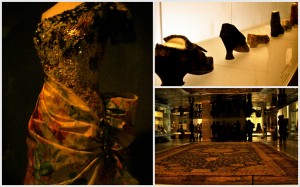
So maybe my culture is not represented here, but as I roamed the Victoria and Albert Museum I realized that some of my interests definitely are. I am a person who highly values artistic performances, self expression through the arts is really important to me, and the Victoria and Albert Museum does a fantastic job at incorporating multiple artistic forms into one beautifully organized building.
Some of the artistic presentations take the form, but are not limited to: sculpting, painting, photography, fashion, design, carpentry and even poetry. I started by observing the sculpture display, made my way through the Japanese and Chinese exhibits of preserved objects, then slowly encountered an interesting section on “Islamic Middle East.” At the “Islamic Middle East” section I was specifically intrigued by a huge carpet laid flat across the floor inside a glass box, it slightly lit for ten minutes on the hour and on he half hour to prevent the colors from fading. This carpet goes by the name of “The Ardabil Carpet” (dated to 1539-40) and is one of the “finest” and “largest” islamic carpets in existence. I was most amazed by its size and the way it was displayed. The chosen form of display majestically asserted its importance. You can tell this carpet took an extensive amount of work to create and so I sat in front of it, and took a moment of my time to appreciate its intricacy.
With infinite excitement, I then proceeded to the fashion exhibit! I had heard about it from one of my peers who visited the museum a few days ago and I was really excited for what was in store. I’ve lived in NYC for about eight years of my life, so I can’t help but to be interested in fashion (as weird as that may sound). The dresses in this exhibit were like paintings, pieces of art work designed with precision, colored with care and story tellers of their own history. As I roamed, I stopped at a window displaying the evolution of the shoe. Suddenly, I thought back on something professor Qualls said at one of our most recent class discussions: “Progress can be good, but for who?” I was observing the evolution of the shoe, the progress of this everyday item, this extremely useful item that some of us filled our suitcases with. But who’s shoe is evolving? Who wore these fancy shoes, who’s progress was this? What about the people without shoes? I asked myself. From that moment on I knew my own questions would prevent me from enjoying the rest of this exhibit so I left this part of the museum. I stopped by the fairy tale furniture exhibit as well as the heaven and hell, quickly perused the small pathways until I realized that it was time for me to gather with the rest of my peers.
I entered the garden on my way out, where I was mesmerized by the peace I suddenly found there, although short-lasting it was very filling. As I reflected on the things I saw at this museum I realized that, slowly, I am finding the “me” in the streets of London. At the museum I found many of my interests and soon, as we do more learning and exploring I am confident that I will find more parts of who I am in the parts of London we have yet to explore.
Tags: Flow · Uncategorized
Unexpected but much appreciated
September 1st, 2009 · 1 Comment
It has been awhile since I have actually stepped back and appreciated how much work and effort goes into a theatrical production. My last personal experience with a theatrical production was playing in the pit orchestra in a high school production of “How to Succeed in Business without Really Trying” during my sophomore year. The last time I had performed in a play or helped with costumes and set was in fifth grade. Needless to say, I had allowed myself to forget the hard work and dedication required to put on a successful theatrical production. Obviously I have attended numerous plays, musicals and operas since then, but I only viewed it as an audience member paying attention to the final product. I had forgotten to appreciate the intricacies of sets, costumes, rehearsals, props, and production staff. This held true even up until last night when we saw Arcadia. I loved the play and found the script to be beautifully written in order to convey a powerful message concerning time and how it passes. Yet the details of the lighting, set, props and backstage work escaped me.
It was not until this morning’s discussion with Rick Fisher that I began to understand the intricacies of lighting, sets, and other backstage work. I wish we could have talked with him before seeing Arcadia. Looking back, I can understand the importance of lighting beyond the obvious cues it provides. Truly, it made me more appreciative of the lighting design we experienced with Arcadia. It was simple but artistic in that it successfully conveyed not only the time of day but the difference in the time periods. At that time I had decided to appreciate the lighting and other backstage works of the plays we would be seeing in the rest of our time in London. I thought that would be the end of it. Yet, I found that our backstage tour at the National Theatre really drove home that point. Not only did it further my newfound appreciation for the collaborative effort required to produce a theatrical even, but it also revitalized my excitement for the theater. A few years had passed since I had been truly excited to see, experience and appreciate a theatrical production. But, with this new appreciation and insight about the production of a play I find myself with a new found passion for the theater. This is something I did not expect from our time in London. I thought I would find myself discovering passions for the city, its architecture, parks, museums, et cetera; not for theater. It is a wonderful discovery and one that will be far too easy to indulge in while we are here and in Norwich. Hopefully, I can take this with me when we return in June but for now I am more than content to take this new knowledge and explore the theaters and plays of London and Norwich.
Tags: Kimberly · Uncategorized
Finding myself in the walls of the V&A
September 1st, 2009 · No Comments
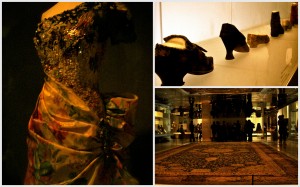
So maybe my culture is not represented here, but as I roamed the Victoria and Albert Museum I realized that some of my interests definitely are. I am a person who highly values artistic performances, self expression through the arts is really important to me, and the Victoria and Albert Museum does a fantastic job at incorporating multiple artistic forms into one beautifully organized building.
Some of the artistic presentations take the form, but are not limited to: sculpting, painting, photography, fashion, design, carpentry and even poetry. I started by observing the sculpture display, made my way through the Japanese and Chinese exhibits of preserved objects, then slowly encountered an interesting section on “Islamic Middle East.” At the “Islamic Middle East” section I was specifically intrigued by a huge carpet laid flat across the floor inside a glass box, it slightly lit for ten minutes on the hour and on he half hour to prevent the colors from fading. This carpet goes by the name of “The Ardabil Carpet” (dated to 1539-40) and is one of the “finest” and “largest” islamic carpets in existence. I was most amazed by its size and the way it was displayed. The chosen form of display majestically asserted its importance. You can tell this carpet took an extensive amount of work to create and so I sat in front of it, and took a moment of my time to appreciate its intricacy.
With infinite excitement, I then proceeded to the fashion exhibit! I had heard about it from one of my peers who visited the museum a few days ago and I was really excited for what was in store. I’ve lived in NYC for about eight years of my life, so I can’t help but to be interested in fashion (as weird as that may sound). The dresses in this exhibit were like paintings, pieces of art work designed with precision, colored with care and story tellers of their own history. As I roamed, I stopped at a window displaying the evolution of the shoe. Suddenly, I thought back on something professor Qualls said at one of our most recent class discussions: “Progress can be good, but for who?” I was observing the evolution of the shoe, the progress of this everyday item, this extremely useful item that some of us filled our suitcases with. But who’s shoe is evolving? Who wore these fancy shoes, who’s progress was this? What about the people without shoes? I asked myself. From that moment on I knew my own questions would prevent me from enjoying the rest of this exhibit so I left this part of the museum. I stopped by the fairy tale furniture exhibit as well as the heaven and hell, quickly perused the small pathways until I realized that it was time for me to gather with the rest of my peers.
I entered the garden on my way out, where I was mesmerized by the peace I suddenly found there, although short-lasting it was very filling. As I reflected on the things I saw at this museum I realized that, slowly, I am finding the “me” in the streets of London. At the museum I found many of my interests and soon, as we do more learning and exploring I am confident that I will find more parts of who I am in the parts of London we have yet to explore.
Tags: Uncategorized
“Time is a Social Construction”, What would we do without it?
September 1st, 2009 · 1 Comment
Since the first day that we arrived at the Arran Hotel, I have been grappling with this concept of time and the need for humans to categorize everything. Humans have become completely reliant on categories, words, titles, definitions, labels etc. It is has been completely imbedded in us to put a title on everything, whether it is clothes, race, gender, sexuality, measurements, concepts, and what I realized today, time. Even time is broken down into different categories, years, months, weeks, days, hours, minutes, seconds and so on and so forth. As I tell you of my endeavors today, and do my best to inform you of my epiphany and how to dissect the concept of time, try to imagine a world where time did not exist, instead think about just being. If that even makes sense.
Today I traveled not only the world, but back in time. I began my day in London as I walked with friends to grab brunch before beginning my adventures. We decided that Subway would be a satisfying and well balanced meal before leaving the country and our present day. We ate a quick bunch because we were eager to see what the rest of the world had to offer. Once our bellies were filled with double turkey and cheese (literally we all had the same thing) we headed out.
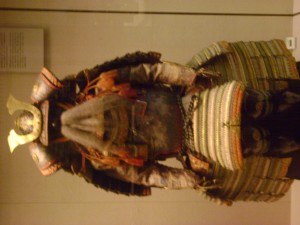
 Our machine that would transcend both countries and time was guarded by a huge gate. The name of it was the British Museum and as we entered people of all different ethnicities, and classes were leaving and coming from their own journey’s. The vast time capsule greeted us and as we traveled up the stairs we had already decided our first destination would be Egypt. We passed through time and space at the speed of well, us because the stairs were quite numerous, but once we arrived we were greeted by Egyptian royalty, and mummies. The exhibit was gorgeous and the mummies, plenty, but as I stared at the mummies, I could not get the concept of time out of my head. Dancing in my mind was the fact that at one point these mummies were alive, and now thousands of years later here I am looking at their preserved corpses. I soon was able to focus on the beautiful pieces in front me and tried to push the ideas in my head aside for future analysis. We saw many other exhibits, including one on Japan, and another on North America. Each exhibit shared both the culture and the history of its people. Thinking of the past present and future of the many different cultures of the world quickly brought me back to this concept of time, but for the sake of time, I decided to visit another museum.
Our machine that would transcend both countries and time was guarded by a huge gate. The name of it was the British Museum and as we entered people of all different ethnicities, and classes were leaving and coming from their own journey’s. The vast time capsule greeted us and as we traveled up the stairs we had already decided our first destination would be Egypt. We passed through time and space at the speed of well, us because the stairs were quite numerous, but once we arrived we were greeted by Egyptian royalty, and mummies. The exhibit was gorgeous and the mummies, plenty, but as I stared at the mummies, I could not get the concept of time out of my head. Dancing in my mind was the fact that at one point these mummies were alive, and now thousands of years later here I am looking at their preserved corpses. I soon was able to focus on the beautiful pieces in front me and tried to push the ideas in my head aside for future analysis. We saw many other exhibits, including one on Japan, and another on North America. Each exhibit shared both the culture and the history of its people. Thinking of the past present and future of the many different cultures of the world quickly brought me back to this concept of time, but for the sake of time, I decided to visit another museum.


We headed back to the hotel to pick up a few more “time travelers”. Once we everyone was ready we headed to the tube station. As a topic of conversation one of the students asked what was everyone going to do there next blog about. I shared with them that I was trying to center mine about the concept of time. Then one student shared their idea that “time is a social construction.” Now being an American Studies major I am all too familiar with the concept of social constructions, but for some reason the fact that time was a part of that list was something I never connected with. I continued the rest of our journey to the Victoria and Albert museum trying to dissect this sudden epiphany.
Now of all the museums I have visited since arriving in London the Victoria and Albert museum is by far the most amazing in my opinion. Once departing off the train the group and I walked down a vast tube like path and at the end was an entrance straight into the sculptures section. Immediately I was blown away by the detail that each of the pieces consisted of. Each sculpture portrayed a message or told a story of some sort which struck me, seeing as how before they were created they were nothing but stone. I next made my way through decades of fashion, paintings, and the history of numerous cultures, and with each one I began to appreciate not only their art but their history, their story spanning time for thousands of years.
I learned today how reliant mankind is on time, and the fact that time doesn’t really exist. Before men and women even came up with the concept of time, things just existed, lived and died, were created and destroyed. There was no dependency on time, but now it has been imbedded in our culture as something normal. Thinking about it I love the whole idea of time, but I do find flaws in it as well. The fact that life has become a series of planned and scheduled events disgusts me, the fact that we count the years as we all age, and how we mark the days as they go by. Time is such an unnatural concept, something that no other species on this planet is aware of. I appreciate time and the moments I share with people but when discussing the true reason for time and its creation, I am finding that I am displeased with this invention of man.
Tags: Anthony · Uncategorized
Telling Tales
August 30th, 2009 · No Comments
I love museums. I like to put my ipod on and wander around alone, allowing myself to really get the full experience of the art. It feels like I’m connecting to not only the piece of art itself, but to the artist and his or her experiences and emotions.
On Saturday, Amy and I took the tube to Charing Cross to visit The National Gallery. There we proceeded to immediately get lost in the extensive building, but we weren’t complaining. We wandered through room after room that held amazing works by Rembrant, Van Gogh, Monet, Leonardo da Vinci, Cezanne, and Turner, just to name a few of my favorites. I compared this museum to the Met in NYC: both are enormous, well cared for, and very popular. However, I noticed a key difference. This difference is simply that most museums here are free, with a just a suggested donation, unlike the Met which charges 10$ per visitor. I love that England honors the historical and cultural value of artwork by making it accessible to the general public. Not only could I observe famous works of art, but I could also examine the evolution of religious practices, social castes, daily life, and even fashion free of cost.
This is a pretty good segway into discussing the museum I visited today: the Victoria and Albert Museum, commonly referred to as the V & A. As a small group, we left from Euston Station to take the central line directly to South Kensington where the tube conveniently led us straight into the museum.
At first, I really didn’t know what to expect of this experience…I mean, I know very little about fashion and I simply wasn’t sure how I was going to be able to relate to the displays.
Yet, as is often the case, I was pleasantly surprised.
I walked into a room filled with some of the most beautiful sculptures I have ever seen. Though I had never heard of most of the sculptors, I was able to get really close to each of the statues and really examine the detail and expression in each.
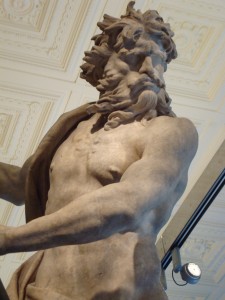
With my head phones in and the world tuned out, I strolled around. There was a huge exhibit on the evolution of clothing, another on shoes & accessories, another on fashionable metal-ware (pots, religious idols, masks, etc).
It was really cool to see how our everyday lives have been affected by the trends of the past. We often hear that things are “out of style” or “not in fashion anymore” but have we really stopped to contemplate what that means? Fashion is constantly fluctuating and changing and all of us, (whether you consider yourself fashion forward or not), are players in this game. We ourselves are walking works of art, displaying the genius of designers as they mold trend after trend, mixing past and future to create something entirely new. And that, at least to me, is fascinating. The thought that I am connected to the past through the evolution of fashion really intrigues me and I would never even have noticed this unless I’d visited the V& A museum!
Another exhibit that I thought was amazing, literally AMAZING, was located in the main lobby of the museum. It was called “Telling Tales; Fantasy and Fear in Contemporary Design” created by international designers Tord Boontje, Maarten Baas, Jurgen Bey and Studio Job who were all inspired by the classic fairy tales which they then translated into their construction offurniture. I know it sounds almost comical (like really, how can furniture be at all interesting) but I’d never seen anything like it. I posted a link a little further down that gives you a little tour.
Also in this exhibit was a frightening, but brilliant, room that entitled “Heaven and Hell”. I won’t give all of it away because I cannot adequately describe it, but the link below also can give you an idea of what to expect. However, I will say this, the lighting, color, back drops, music, and the positioning of the art are all major contributors to the overall effect of the art and are carefully constructed by the artists/museum staff. Basically, see it in person because you won’t regret it.
http://www.vam.ac.uk/microsites/telling-tales/exhibition.html
This exhibit only lasts until October 18th, and I suggest everyone see it while here. Truly, both the National Gallery and the V&A are exceptional and I really enjoyed having the opportunities to both observe and reflect on my experiences.
Tags: Maddie · Museums · Uncategorized
Whatever happened to resting in peace?
August 30th, 2009 · 1 Comment
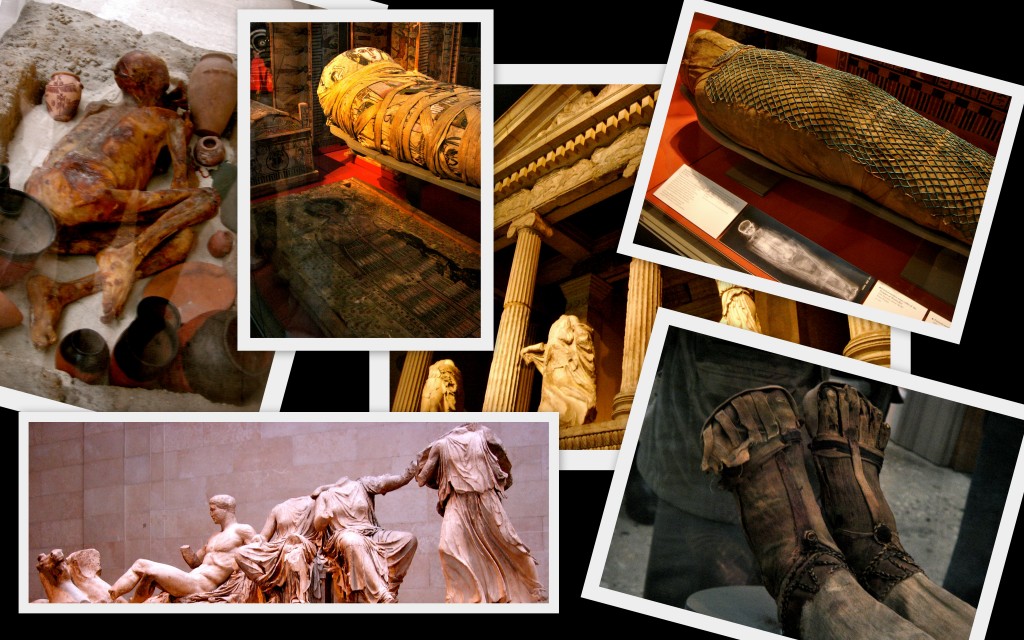
[Author’s note: I am a lover of museums, I enjoy the idea of presenting something for public admiration, yet the following post is a type of critique directed towards museum culture. The questions I pose seek responses and if you can and are willing to I am more than happy to receive responses and to discuss comments and ideas.]
Every civilization constructs themselves in unique ways, develops rituals, cultural symbolisms and folklore depending on the values, morals and believes of either a powerful minority or the general population. When I visited the British Museum today I was at awe at the number of Egyptian objects on display and could not help but to inquire about their present state. I know this is a museum and the point is to display objects of interest to the general public, after all that is how revenue is made and popularity is obtained, the “weirder” the object the more people that want to come see, but why? I realized that museums practice a form of cultural fragmentation, they present to the audience a piece of a culture/civilization, the one that we (as the audience) will be most intrigued by; again, but why? why are we always fascinated with that which is different from the things that we know (as “normal”)? What makes us so superior that we have taken the right to place other cultures on display as if they were commodities? Thousands of years displayed in one room, objects preserved for a lifetime and …mummies on display? Whatever happened to resting in peace?
If Egyptians believed in placing specific objects in the tombs of their pharaohs for the after life then guess what, we have totally screwed up thousands of years of ritualized mummification for the sake of cultural representation. For as silly as this may sound I was a bit saddened to realize that if Cleopatra came back in her after life she would have no wealth, it has been divided among different museums and collectors all overt eh world. Her mummy was assigned a resting place, a burial ground, for a reason, and by removing her from that environment we have damaged the fabric of one of the world’s most intricate civilizations. How dare we disrupt the living dead? How dare we destroy sanctuaries, transport them across the globe, and study them as if they were meant to be objectified in the first place.
Although, I was extremely impressed at the sculptures of the Parthenon (located at the exhibit on Greece at the British museum), once again I asked myself: Why are these magnificent structures here? Why are they not at the Parthenon where they belong? Later in the day I learned from on of my classmates that it’s a complicated history which most of us know nothing of. She explained to me how parts of the Parthenon were being stolen from their original site, and so someone “rescued” pieces in order to preserve what was left of it (these are some of the pieces on display). Ok, just maybe some of the objects displayed are righteously justified, but my questions still stand: why are we always fascinated with that which is different from the things that we know (as “normal”)? What makes us so superior that we have taken the right to place other cultures on display for our own leisure?
The questions rumbling through my mind make me think back on my Workshop in Cultural Analysis class last semester (at Dickinson) where we discussed issues with cultural representation, fragmentation, fetishism, commodity culture, among others. In this class I wrote a paper in which I argued that much of the discourse we know as “truth” (regarding the representation of different cultures) is based on the believes of a powerful minority. In the words of Bell Hooks (author of “Teaching to Transgress” and “Ain’t I a woman,” among others):
Within commodity culture, ethnicity becomes spice, seasoning that can liven up the dull dish that is mainstream white culture. Cultural taboos around sexuality and desire are transgressed and made explicit as the media bombards folks with a message of difference… bringing to the surface all those “nasty” unconscious fantasies and longings about contact with the Other embedded in the secret (not so secret) deep structure … In many ways it is a contemporary revival of interest in the “primitive.”
Even though the quote above speaks better to a more sexualized commodification and/or fragmentation of cultures it is relevant in multiple other ways. As a superpower Britain (as well as the US) have been the “main dish” seeking “spice” to “liven [themselves] up.” Both predominantly “white” civilizations (UK and US) have sought to explore and display the “other” in order to maintain themselves as the “us.”
The questions remain, why display mummies when they were not meant to be exhibited (all over the globe) in the first place?Why do we commodify other cultures, fragmentize them and appraise only a part of them (the part that has been given to us)? Again, every civilization constructs themselves in unique ways, develops rituals, cultural symbolisms and folklore depending on the values, morals and believes of either a powerful minority or the general population. What are we constructing that will be on display a thousand years from now? Would you like to see the complexities of your life minimized to a single cardboard wall (or a short movie clip), on some museum, set up for judgement? Would you like your body to be preserved, put up for auction, displayed on a gallery without your consent? Think about it, how would Cleopatra feel if she was to rise from the dead to tomorrow to find herself in a glass box, on a different continent, far from anything know, separated from her wealth and objects provided to her inside her tomb upon her death?
“A culture is made– or destroyed– by its articulate voices” (Ayn Rand, Russian born American writer and novelist).
Tags: Flow · Uncategorized
Notting Hill and Steel Drums
August 30th, 2009 · No Comments
Today I explored the Notting Hill area and I could imagine it as a vibrant but mostly quiet neighborhood. This holiday weekend however it was transformed by the Carnival that takes over the streets. Carnival has been held annually for almost fifty years and has exploded into one of the largest festivals in London. The event was originally a local West Indian festival that now draws hundreds of vendors in twenty square miles of streets. The streets explode with people, music, and the smells of traditional Caribbean food like jerked chicken or curried goat. The festival goes on for three days the largest and busiest being Monday. I went on Sunday which is considered the children’s day, so the parades were made up of children who would dance down the streets with each different group in charge of a different theme. Due to the massive amounts of people attending the festival the crowds also draw a strong police presence and varying reactions from the residents.
Multiple houses and stores had plywood up in front of their storefronts or the gates of the houses to stop people from entering their yards or defacing their property. Certain streets were cordoned off so that only residents were allowed to enter those sections. What was truly surprising was the variety of participants. A huge portion of the visitors were white Brits interspersed with a multitude of ethnic groups including Indian and Muslim, so identified by the bright saris and full hijabs. However after the initial parade another passed later filled with not just members of the black London population but Caucasian and other groups as well. It was incredible to see an event that can trace its roots back to a small local event for the area to what is now a major attraction to the entire city.
Tags: Uncategorized
Endless Eccentricities of the Victoria and Albert
August 29th, 2009 · 1 Comment
Today we wandered, via the scenic route, over to the Victoria and Albert Museum in South Kensington. We knew that it would be an eclectic and eccentric collection, but we were in for a surprise…
Upon exiting the convient tunnel linking the Tube to several well-visited museums and sites in the area, we found ourselves in a ground floor sculpture hall. Randomly picking a direction to walk in, we wandered into in the fashion section. (Aidan and Brandon were thrilled.) In this collection we found everything from hautecouture to Elizabethan-era ensembles. Some of these clothes were truly shocking! One such item reminded Kelley of a woolly mammoth, but alas, it was a apres ski jacket. While we were lingering by a shirt made from a parachute and some heavily-sequined items, we could see into an exhibit of Raphael’s cartoons.
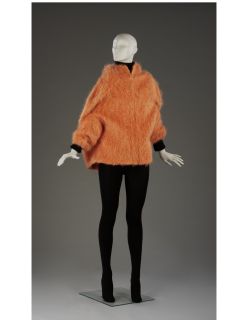
The Woolly Mammoth, erm, Apres Ski Jacket (picture taken from the website of the Victoria and Albert Museum)
A cartoon is a preliminary drawing for either a tapestry or a painting. In this case, the drawings were for a series of tapestries commissioned for Pope Leo X and they depicted a number of scenes from the Bible. We were impressed with the sheer size and careful preservation of the drawings. As one of the completed tapestries was present, it was also interesting to see what the finished product looked like.
We decided simply to wander from exhibit to exhibit in order to understand the Victoria and Albert collection as a whole. We were met with limited success. While the museum contains an extensive array of artifacts from around the globe, we found that there was no logical flow pattern in the museum. For example, we went from Korea to the European Cast Court (essentially a large number of copies of well-known facades and memorials) and again from finely-painted late 19th century tables to the radios of the 20th century. Essentially, we were confused. Why were these objects here and what is the purpose of their order? What is the collection of the Victoria and Albert trying to say to the visitor? It reminded Grace of a really nice yard sale. To Kelley, it was like searching around her grandparent’s basement. We found the artifacts to be very interesting and laid out well within their exhibits,we just question the museum’s purpose as a whole. That said, it was a worthwhile way to spend an afternoon. (We highly recommend going out into the garden and watching the children playing in the paddling pool!)
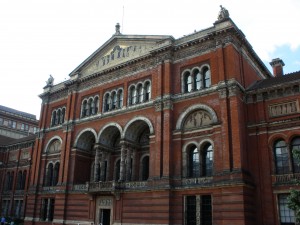
The architecture of the V&A from the garden
Tags: Grace · Kelley · Museums · Uncategorized


